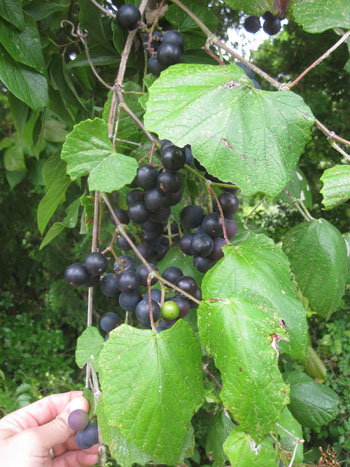Fox grapes Riverbank grapes Summer grapes Sand grapes Post oak grapes Vitis champinii Spanish grapes Frost grapes Mustang grapes Gray-bark grapes Bush grapes Sweet mountain grapes Muscadine grapes For more information
Eric Stafne, Mississippi State University
American grapes are native to North America. They are often used to create interspecific hybrids (also called French-American grapes). American grapes serve as a natural repository for genetic resources or germplasm used to improve cultivated grapevines worldwide.
Fox grape (Vitis labrusca, V. labruscana)
The most well-known American grape. The most famous cultivars from this species are ‘Concord,’ ‘Catawba,’ ‘Niagara,’ and ‘Isabella.’ It has:
- large berries
- small clusters
- fair pest resistance
- a distinctive and strong flavor
Riverbank grape (V. riparia)
Several cultivars have this species in their lineage, such as ‘Beta,’ ‘Clinton,’ ‘Baco Noir,’ ‘Frontenac’, ‘Marechal Foch,’ and rootstocks 3309C, 5BB and SO4. It has:
- small berries
- small clusters
- fair to good pest resistance
- good vigor
- easy rooting (which makes it attractive to use as a rootstock)
- wide variation in ripening time and cold hardiness levels
Summer grape (V. aestivalis)
Mainly known for the cultivar ‘Cynthiana,’ aka ‘Norton’. It has:
- small to medium berries
- medium to large open clusters
- fair pest resistance
- high sugar and high acid, so wine-making can be a challenge
Sand grape (V. rupestris)
Cultivars of this species are ‘St. George’ (aka ‘Rupestris du Lot’) and the rootstock hybrids 110R and 1103P. It has:
- small berries
- small to medium clusters
- good pest resistance
- good vigor
- easy rooting
- a very “wild” taste
Post oak grape (V. lincecumii)
This species is native to the southern plains. Many cultivars have this species in their background, including ‘Bailey,’ ‘Beacon,’ ‘Ellen Scott,’ ‘Marguerite,’ and ‘Rubaiyat.’ This species was hailed by T.V. Munson as being especially important for creating hybrid grape cultivars. It has:
- medium to large berries
- small to medium clusters
- fair pest resistance
- a distinctive “wild” taste, but different from V. labrusca
V. champinii
Cultivars: ‘Champanel,’ ‘Lomanto,’ and ‘Nitodal’. Rootstock cultivars: ‘Salt Creek’ (aka ‘Ramsey’) and ‘Dogridge,’ and rootstock hybrids with V. champinii as a parent: ‘Harmony’ and ‘Freedom.’ Native to Texas.
- small clusters
- medium sized berries
- vigorous
- roots easily
- adapted to lime soils
- resistant to nematodes and other pests
- primarily for rootstock
Spanish grape (V. berlandieri)
- small berries
- medium clusters
- adapted to lime soils
- moderate pest resistance
- poor rooting
Frost grape (V. cordifolia)
- small berries
- medium sized and open clusters
- late ripening
- very vigorous
- poor to medium pest resistance
- bitingly pungent with a strong wild taste
Mustang grape (V. mustangensis, V. candicans)
- small clusters
- medium to large berries
- tough skin
- biting pungency
- tolerant of Pierce’s disease and other pests
Gray-bark grape (V. cinerea)
- vigorous
- small berries
- loose clusters
- tolerates lime soils
- often found in riparian habitats
- ripens late
Bush grape (V. longii)
- medium berries
- small clusters
- early ripening
- roots easily
- adapted to lime soils
- resistant to nematodes and other pests
- used for rootstocks
Sweet mountain grape (V. monticola)
Native to Texas.
- small clusters
- medium sized berries
- moderate vigor
- poor rooting
- adapted to dry and lime soils
Muscadine grape (Muscandinia rotundifolia, V. rotundifolia)
A parent of the rootstock hybrid ‘VR O39-16’
- large berry size
- small clusters
- mild to strong flavor
- poor rooting
- cold tender
- excellent pest tolerance
Recommended Resources
Interspecific Hybrid (French-American) Wine Grapes
Vinifera, or European, Wine Grapes
The Super Gigantic Y2K Winegrape Glossary
Reviewed by Keith Striegler, University of Missouri
and Jim Wolpert, UC Davis

